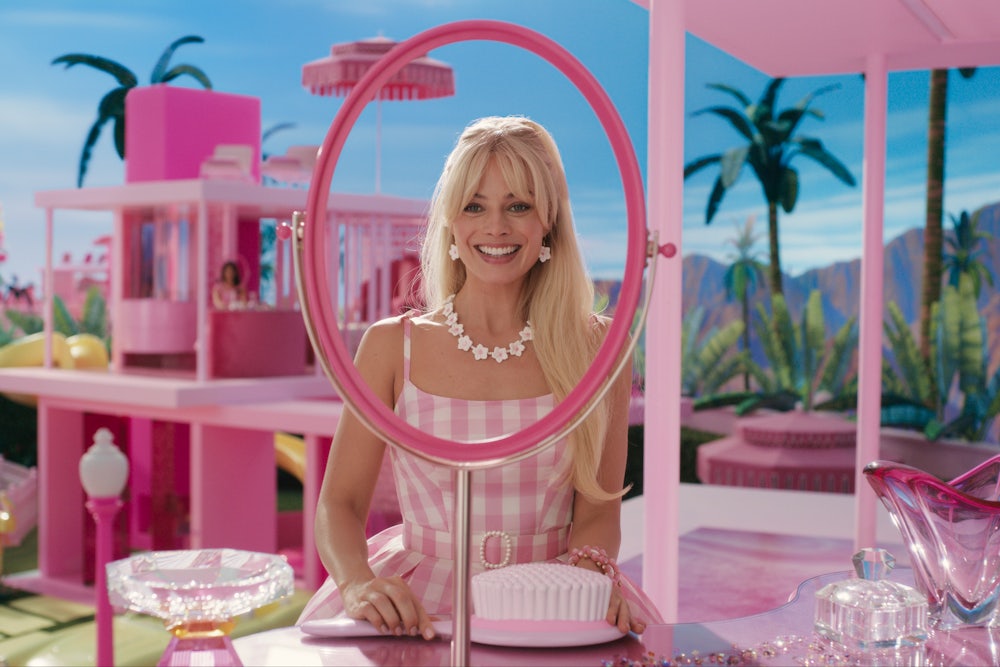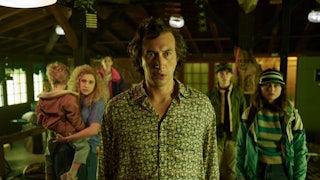There was a good chance Barbie would topple under the weight of its expectations. In the 60 years since she debuted, Barbie has been embraced and disparaged as a paragon of idealized femininity, as a prompt for imaginative play, and as a tool of the patriarchy, upholding oppressive beauty standards and stereotypes. The Barbie movie winks at the doll’s cultural centrality, as it opens with a shot-for-shot remake of the first scene in 2001: A Space Odyssey, which depicts the dawn of human enlightenment. As humans’ precursors discovered the power of tools, little girls encountered a doll that represented an adult woman.
In the months leading up to its release, Barbie was shrouded with a certain mystique—the feminine kind—with trailers obscuring more than they revealed. It became more than a summer blockbuster based on a famous toy, one-half of a cinematic meme, and the vehicle for an increasingly popular “Barbiecore” aesthetic. Director and co-writer Greta Gerwig has leaned into the idea of Barbie as a unifying cultural phenomenon, a girlhood experience so broadly shared that it could bring all kinds of women together. She told The New York Times that she wanted viewers to find in Barbie a sort of benediction, hoping to replicate the feeling she had attending Shabbat dinner with friends as a child. “I want them to get blessed,” Gerwig said, aware of her subject’s cultural baggage. Could Barbie capture the magic of childhood play, while also contending with the doll’s complicated role in American culture?
More or less. (This article contains mild spoilers, so stop reading here if you want to avoid learning more about the plot.) While hardly a sophisticated vehicle for a feminist treatise, Barbie is a bright, creative endeavor that neatly wraps up the struggles of womanhood in a clever package. The film is a pleasing mishmash of genres, with elements fantastical, political, mystical, and musical, but at its core it is a coming of age story, a bildungsroman in shades of pink.
Barbie would be worth seeing in theaters for the visuals alone. Barbie Land, home to the Barbies, Kens, and their various discontinued doll sidekicks, is a colorful pastiche of life in plastic, and it’s fantastic. Watching the opening sequence of Barbie Land, depicting Barbie’s morning routine, makes the viewer feel like a little girl playing in her own plastic dream house. But it’s the main character who gives the world texture: Margot Robbie is incandescent as Barbie, and not only because with her megawatt smile and flowing blonde hair, it is easy to believe that she is a doll come to life.
Robbie is “Stereotypical Barbie”—the Barbie you picture when you think of “Barbie.” Her charmed existence is upended one day when her tiptoed feet start flattening, she experiences a surge of irrepressible thoughts of death, and notices the development of cellulite (gasp!). At a dance party with bespoke choreography, Barbie interrupts the festivities by asking if her fellow dolls ever think about dying.
To combat her existential woes, Barbie must venture into our reality—the Real World—to find and reconnect with the actual person playing with her, whose anxiety is manifesting in Barbie. Accompanied by Ken (Ryan Gosling), and buoyed by the Indigo Girls’ classic “Closer to Fine,” Barbie must discover who she is in the Real World.
Co-written by Gerwig and Noah Baumbach, and directed by Gerwig, this journey is not a huge leap from Gerwig’s previous movies, Lady Bird and Little Women, coming of age stories that portray the difficulties that (white) women face as they discover their complicated identities in a society that seeks to keep them in a box. But in Barbie, the box is real, and made of cardboard. And like its protagonist, the film is impossible to contain in a neat package: It is both more and less than the sum of its parts.
Insofar as the film has a villain, it is the Patriarchy. Within the blissful confines of Barbie Land, the Barbies believe that they have ended sexism in the Real World, by demonstrating that little girls can grow up to be doctors, journalists, and even the president. It’s a nod to the doll’s uneasy role in American culture: While Barbies may include the trappings of personal and professional aspiration, they also represent the impossible standards imposed on women. Robbie’s Barbie expects to be met in the Real World with thanks and embraces from the women whose lives have been improved by the very existence of Barbie; it comes as a shock, then, when a teenage girl eyes her with withering disdain, sneering that Barbie represents a system meant to keep women down.
Although the transition from Barbie Land to the Real World is visually smooth, it is tonally jarring. When Barbie and Ken arrive in Venice Beach, rollerblading down the boardwalk in matching neon outfits, Barbie experiences the humiliation of catcalling for the first time. As men shout and jeer, her confident smile falters, replaced by a troubled frown. In a later scene at the headquarters of Mattel, Barbie is rattled to discover that the entire executive board is comprised of men, led by a hapless CEO (Will Ferrell) who describes himself as the “nephew of a woman aunt.” (Mattel clearly was game to be ribbed in Barbie, but they are also expecting it to make them a lot of money.) Bumbling male employees chase her through the corporation’s drab cubicles, attempting to put her back in the box.
Is this self-aware struggle against a rather obvious manifestation of the Patriarchy enough to exorcize the oppressive ideals that have hung around Barbie for decades? The movie lovingly depicts Barbie’s routine as a source of fun rather than of intense pressure, reveling in her commitment to pink, the intensive grooming, the frequent changes in hairstyles and outfits. And it strives to show that Robbie’s Barbie is not the only version of the doll in Barbie Land: She is surrounded by Barbie friends of different races, sizes, body shapes, and physical ability (one of the Barbies uses a wheelchair). The president of Barbie Land is a Black woman, played by Issa Rae, and its Supreme Court is entirely female.
Yet at times, Barbie risks veering into what critic Maureen Ryan identifies as “plastic representation”—the idea that it is enough to have characters of diverse backgrounds without providing any cultural context for their experiences. In the Real World, America Ferrera portrays the film’s avatar of an everyday woman, an overworked mom named Gloria who works as an executive assistant at Mattel. We see Gloria struggle with bills, the everyday sexism of her boss, and the increasing disinterest of her teenage daughter. Toward the middle of the movie, Gloria gives a rousing speech about the suffocating ordeal of being a woman, a sort of G-rated version of the “cool girl” monologue in Gone Girl. But without the acknowledgment of how being working class and Latina particularly complicates those experiences, the argument feels somewhat hollow.
Perhaps it would be too much to ask for Barbie to identify how racism, classism, ableism, and other forms of discrimination affect the daily experiences of women under the Patriarchy. But the movie set itself the considerable challenge of rehabilitating a toy that, to many women, exemplifies unrealistic and harmful standards of physical beauty, drummed into girls from an early age. The scope of that task would be daunting for any film, and particularly for one that, by its own acknowledgment, makes the stereotype of a beautiful white woman its protagonist. As the narrator, voiced by Helen Mirren, wryly notes at one point, Margot Robbie is perhaps not the best example of a woman who no longer looks perfect once she has cried away all of her makeup.
But the biggest problem with Barbie may be Ken. When he travels to the Real World with Barbie, he is not dismayed by the Patriarchy but buoyed by it. Back in the female-dominated Barbie Land, Ken was the underdog. “I think a lot of Kens will feel seen when they see this. Gotta do it for the Kens. No one plays with the Kens,” Gosling told Variety last year. As Ken sings in a plaintive ballad, “Anywhere else, I’d be a 10.” When he reaches the Real World, he is enchanted by the trappings of masculinity, and returns to Barbie Land intent on turning it into another bastion of male pride and power.
To its credit, the film attempts to illustrate that the Patriarchy is a trap for men as well as women, also subjecting them to unrealistic standards and preventing them from cultivating their own identity. Yet this aspect of the plot—a beautiful man having an identity crisis—is not as unique as Barbie seems to think it is; there are a million stories about Kens searching for their purpose. Like Barbie Land, Hollywood may fixate on female beauty, but it is a world all but made for the Kens.
Yet the film captures Barbie’s persistent magic, its ability to inspire little girls to see themselves as individuals, their identities not premised on being a wife or a mother. There is also something enchanting about seeing Barbie Land come to life: Barbie doesn’t walk down the stairs in the morning but gently floats from her bedroom to the kitchen, as if her movements were guided by a little girl.
Barbie is surprisingly spiritual, treating the messiness and contradictions of womanhood with reverence. In the film, Barbie has more than one vision of almost religious significance. In order to identify her connection with her human counterpart in the Real World, Barbie sits on a park bench, remembering the life experiences of the real woman as if they were her own. She opens her eyes, tears gently rolling down her cheeks, like a saint who has witnessed the divine.
The goals of Barbie are, perhaps, overly lofty. There’s only so much a filmmaker can accomplish in a glittery tale about a blonde doll and her ditzy sidekick, no matter how well acted and constructed. Barbie learns that it is impossible to achieve perfection in a complicated world; similarly, one movie can’t encompass the entire experience of womanhood. Maybe it should not be expected to carry that burden.






